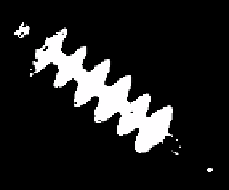Graphics Reference
In-Depth Information
(a) (b)
Fig. 2.
Im 1 and its binary image. (a) Im 1. (b) Its binary image
2.1.2 Morphological Filtering
Shown in Fig. 2(b), there are a lot of internal holes inside the insulator, and the edges
are blurry which lead to difficult edge extraction. This paper adopts double cascade
filtering method to erode and dilate the binary image. And after morphological filter-
ing, internal holes of Im 1 are filled basically, and the edges become smoothness and
clearness in Fig. 3(a).
There are also some residual small regions after filtering seen from Fig. 3(a). Set a
threshold and remove the regions whose areas are less than the value shown as Fig.
3(b) that improves accuracy of the detection of insulator's orientation angle and sim-
plifies the computation.
(a) (b)
Fig. 3.
Results of preprocessing of Im 1. (a) Result of morphological filtering of Im 1. (b) Re-
sult of preprocessing of Im 1.
2.2
Orientation Angle Definition for Edges
Extract the contours of Im 1 shown in Fig. 4(a), and link edge pixels together into lists
of sequential edge points, one list for each edge contour. A contour starts/stops at an
ending or a junction with another contour. And the contour would be discarded if it is
less than a specific value.
The contour of binary image is concave-Convex and irregular curve after prepro-
cessing, which brings a lot of trouble for the orientation angle detection of insulator.
This paper uses a large number of straight line segments with specified tolerance to




Search WWH ::

Custom Search